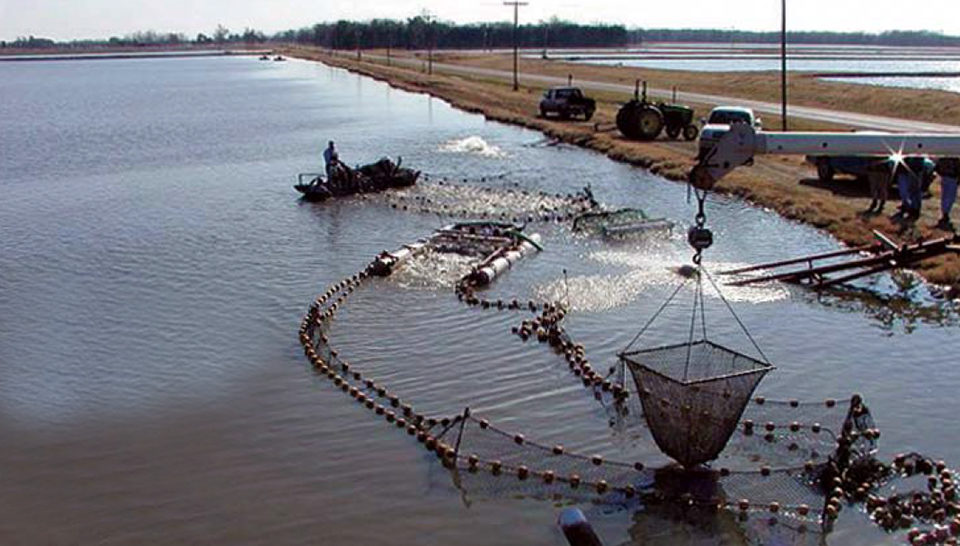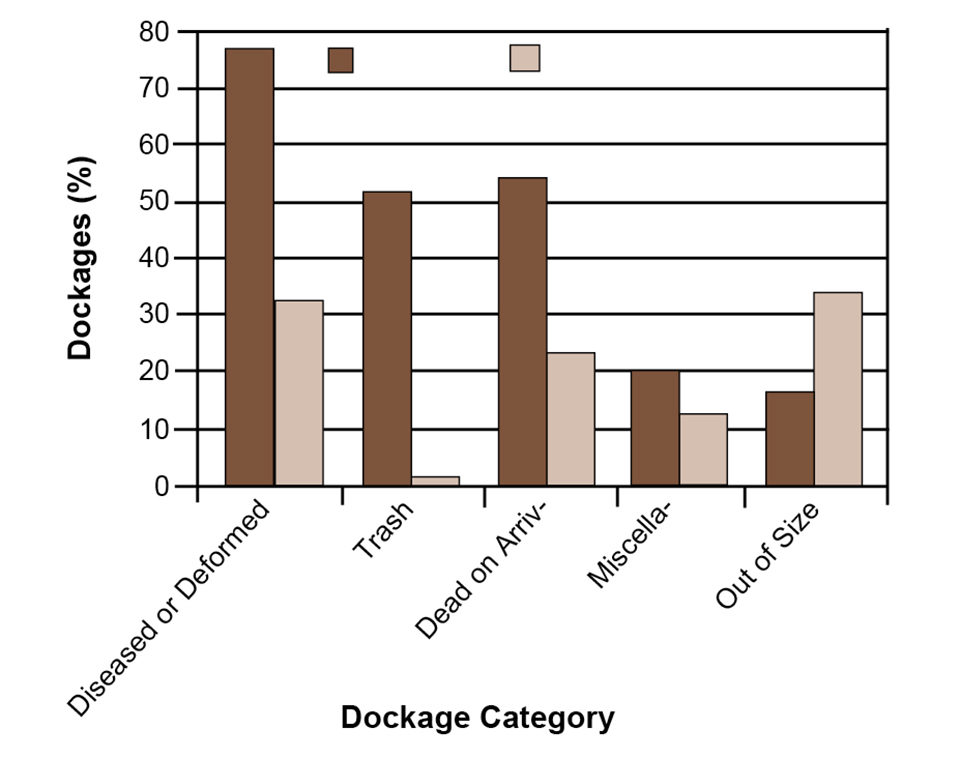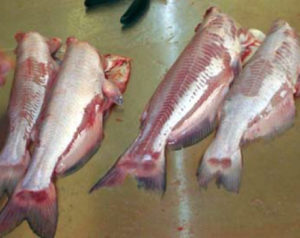Model proposes use of in-pond bar graders

Processing plant dockages – reductions in either delivered fish weight or the price paid to farmers for their product – are assessed for fish that do not meet plant specifications. Despite advances in catfish processing, dockages continue to be a matter of trust between farmers and their processors that can also cause tension, especially during times of low price, when plants tighten their policies and farmers scramble for break-even returns.
Catfish dockages
Dockages at processing plants can be grouped into five general categories: out of size, diseased or deformed, dead on arrival, trash, and miscellaneous. Out-of-size catfish do not meet the size tolerance specifications of the processing plant. Size specifications vary, but usually range 0.45-0.57 kg up to 1.81-2.26 kg. Tolerance of out-of-size levels also varies, but a 5-10 percent tolerance on the smaller size limit is commonly used before a discount is applied. Fish in the remaining four dockage categories are rejected from the total delivery weight and commonly referred to as “weighbacks.”
Weighback categories cover a variety of dockages. Diseased and deformed animals are flawed fish that have twisted backbones, lesions, or sores. Dead catfish have likely succumbed to the stress of harvesting, grading, and hauling. The trash designation can include turtles, other fish species, and even wood, metal, and debris. The -miscellaneous category includes shorts, low dress-out weights, and anything else deemed unacceptable by the plant.
Rejected fish are removed from the processing line and weighed by category. Their weight is then subtracted from the total weight delivered. Weighbacks can also be subject to a handling fee of U.S. $0.33-0.44 per kilogram.
A survey of southern Arkansas producers and processing plants revealed that 95 percent of catfish loads had dockages assessed for loads delivered between 1997 and 2002. The total revenue loss as a percentage of the gross value was 2.5 percent or U.S. $.033 per kilogram of catfish delivered to the processing plants. Further analysis showed that out-of-size catfish represented the most significant loss of revenue for farmers (Fig. 1).

Dockage model
A profit optimization model developed at the University of Arkansas at Pine Bluff for out-of-size dockages used data from production experiments as well as commercial catfish farm production data to determine grow-out and grading strategies for optimized profits with various dockage scenarios. The model examined 11 production strategies, five grading techniques, and 24 dockage possibilities, along with long- and short-term cash decisions for a 65-ha pond production system.
Production strategies were broken into single-batch and multiple-batch systems. Single-batch production utilized one year class of fish in a pond, while multiple-batch production utilized multiple year classes. Single-batch systems were grown 98, 134, 164, or 210 days, and stocked at 8,646-13,585 fish per hectare. Multiple-batch systems were grown 147, 186, or 242 days, and stocked with 11,115 stockers and 14,280 fingerlings per hectare.
Gross revenue ranged U.S. $3,632-7,370 per hectare, and variable costs ranged $3,338-5,682 per hectare. Out-of-size fish represented from less than 1 percent to over 38 percent of the total production. Grading was done with 445-mm and 476-mm stretch net graders and an in-pond catfish bar grader developed at the University of Arkansas at Pine Bluff set at 445 mm and 508 mm. Dockage rates were combinations of 0.45 and 0.57 kg minimum weights; $0.33 per kilogram and $0.66 per kilogram discounts; and 0, 5, and 10 percent tolerances with a 0 percent tolerance for catfish greater than 1.81 kg.
Model results

The optimal production strategy identified by the model was a single-batch production system grown for 210 days. This was the superior strategy because the majority of the population surpassed the minimum size requirements and dockage penalties were not incurred. Moreover, only a small percentage of fish reached the 1.81-kg size that would trigger the over- size dockage penalties. The production scenario had the highest revenues and lowest discount costs of all the production scenarios considered.
Although the single-batch production system was the most profitable, the industry standard is multiple-batch production. The multiple-batch system can generate cash flow on a continuous basis, even in the presence of off-flavor-induced market constraints. In contrast, the 210-day single-batch production did not generate cash flow until the end of the production cycle.
When the model was forced to choose a multiple-batch scenario, it selected the multiple-batch production system grown for 242 days. The primary reason for this selection was the small number of fish below the minimum market size specifications of the plant. Without accounting for the value of small fish returned to the pond, the model chose not to grade in the majority of scenarios because, with the longer production system selected, few fish were out of size. When the value of small fish returned to the pond was included, the model chose the grader bar for all scenarios.
The percentage of the fish population below minimum market size heavily influenced the grader selection process. The 210-day single-batch system had very few fish that needed to be graded. The 242-day multiple-batch system had small fish that needed to be removed, but not as many directly at the split point, so they were more effectively removed by the graders.
The commercial ponds had a smooth fish distribution indicative of continuous multiple-batch production. However, this smooth distribution also had higher numbers of fish near the split, or minimum market size. Bar graders offered the advantage of more accurately splitting the population for situations in which the net graders retained too many sub-harvestable fish.
The most profitable production practice, with respect to plant dockage policies, is to grow catfish in a single-batch system until the size distribution lies within plant specifications. However, due to factors such as off-flavor, cash flow constraints, diseases, and marketing, producers usually use multiple-batch systems. With multiple batches, the optimal grading practice depends on discount tolerances and the size distribution of the population. Long term, bar graders are more profitable despite their higher production cost.
(Editor’s Note: This article was originally published in the June 2006 print edition of the Global Aquaculture Advocate.)
Now that you've finished reading the article ...
… we hope you’ll consider supporting our mission to document the evolution of the global aquaculture industry and share our vast network of contributors’ expansive knowledge every week.
By becoming a Global Seafood Alliance member, you’re ensuring that all of the pre-competitive work we do through member benefits, resources and events can continue. Individual membership costs just $50 a year. GSA individual and corporate members receive complimentary access to a series of GOAL virtual events beginning in April. Join now.
Not a GSA member? Join us.
Authors
-
Nathaniel Wiese
Aquaculture/Fisheries Center of Excellence
University of Arkansas Pine Bluff
1200 North University Drive, Box 4912
Pine Bluff, Arkansas 71601 USA -
Carole Engle, Ph.D.
Aquaculture/Fisheries Center of Excellence
University of Arkansas Pine Bluff
1200 North University Drive, Box 4912
Pine Bluff, Arkansas 71601 USA
Tagged With
Related Posts

Health & Welfare
Antigens provide immunity against ich in channel catfish trials
Vaccination against the Ich parasite is an alternative to chemical treatment. Fish develop a humoral immune response to trophont antigens, with the degree of protection related to the immunizing doses of trophonts used.

Health & Welfare
A look at aquaculture in Guyana
With its large quantities of water and little industry to pollute it, Guyana has the potential to become a greater player in global aquaculture.

Aquafeeds
A look at corn distillers dried grains with solubles
Corn distillers dried grains with solubles are an economical source of energy, protein and digestible phosphorus to reduce feed costs and fishmeal usage.

Health & Welfare
A look at tilapia aquaculture in Ghana
Aquaculture in Ghana has overcome its historic fits and starts and is helping to narrow the gap between domestic seafood production and consumption. Production is based on Nile tilapia.


